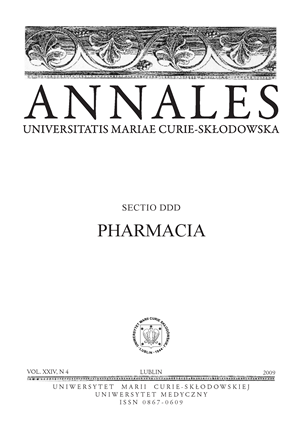Cukrzyca ciążowa – aktualności ‘2009
Abstrakt
Cukrzyca ciążowa jest najczęstszym powikłaniem metabolicznym komplikującym przebieg ciąży, a jej częstość występowania jest zróżnicowana. Z uwagi na bezobjawowy przebieg choroby powinny być wykonywane badania przesiewowe, ponieważ nieleczona zwiększa ryzyko powikłań zarówno u płodu i noworodka, jak również u matki. Pomimo tego, że najczęściej ustępuje wraz z rozwiązaniem ciąży, to pozostaje silnym czynnikiem zachorowania matki na cukrzycę w przyszłości, zatem niezbędna jest rediagnostyka po urodzeniu dziecka. Artykuł przedstawia stan wiedzy na temat cukrzycy ciążowej w zakresie patogenezy, diagnostyki, leczenia i rokowania.
Bibliografia
1. Bellamy L. et al.: Type 2 diabetes mellitus after gestational diabetes: a systematic review and meta-analysis. Lancet, 373, 1773, 2009.
2. Clausen T. D., Mathiesen E. R., Hansen T. e al.: High prevalence of type 2 diabetes and pre-diabetes in adult offspring of women with gestational diabetes mellitus or type 1 diabetes: the role of intrauterine hyperglycemia. Diabetes Care, 31 (2), 340, 2008.
3. Cypryk K., Szymczak W., Czupryniak L. et al.: A Gestational diabetes mellitus – an analysis of risk factors. Endokrynol. Pol., 59 (5), 393, 2008.
4. Damm P.: Gestational diabetes mellitus and subsequent development of overt diabetes mellitus. Dan. Med. Bull., 45 (5), 495, 1998.
5. Ferrara A. et al.: Increasing Prevalence of Gestational Diabetes Mellitus. A public health perspective. Diabetes Care, 25, 1625, 2002.
6. Hayes C.: Long-term prognostic factors in the diagnosis of gestational diabetes. Br. J. Nurs., 18 (9), 523, 2009.
7. Jovanovic L. Point: Oral Hypoglycemic Agents Should Not Be Used to Treat Diabetic Pregnant Women. Diabetes Care, 30 (11), 2980, 2007.
8. Jovanovic L., Pet t it t D. J.: Gestational diabetes mellitus. Jama, 286 (20), 2516, 2001.
9. Kim C., Newton K. M., Knopp R. H.: Gestational diabetes and the incidence of type 2 diabetes: a systematic review. Diabetes Care, 25 (10), 1862, 2002.
10. King H.: Epidemiology of glucose intolerance and gestational diabetes in women of childbearing age. Diabetes Care, 21, Suppl 2, 13,1998.
11. Kirwan J. P., Hauguel-de Mouzon S., Lepercq J. et al.: TNFα is a predictor of insulin resistance in human pregnancy. Diabetes, 51, 2207, 2002.
12. Langer O.: Fetal macrosomia: etiologic factors. Clin. Obstet. Gynecol., 43 (2), 283, 2000.
13. Matuszek B. et al.: Adiponectin concentractions in pregnant women with gestational diabetes mellitus. Pol. J. Environ. Stud., 15 (24), 1407, 2006.
14. Melczer Z, Bánhidy F., Csömör S. et al. Influence of leptin and the TNF system on insulin resistance in pregnancy and their effect on anthropometric parameters of newborns. Acta. Obstet. Gynecol. Scand., 82, 432, 2003.
15. Oleszczuk J., Pilewska-Kozak A., Kanadys K.: Cukrzyca w okresie ciąży. In: A. Bień (ed.): Opieka nad kobietą ciężarną. PZWL, 242, Warszawa 2009.
16. Raport of a WHO Study Group. Geneva World Health Org.: Definition, diagnosis, and classification of diabetes mellitus and its complications. Geneva 1999. Med. Prakt., 1-2, 85, 2000.
17. Retnakaran R. et al.: Reduced adiponectin concentration in women with gestational diabetes: a potential factor in progression to type 2 diabetes. Diabetes Care, 27, 799, 2004.
18. Singh C., Jovanovic L.: Insulin analogues in the treatment of diabetes in pregnancy. Obstet. Gynecol. Clin. North. Am., 34 (2), 275, 2007.
19. Speroff L., Fritz M. A.: Kliniczna endokrynologia ginekologiczna i niepłodność; Medipage, 293, Warszawa 2007.
20. Styne D.: Wzrost i rozwój. In: F.S. Greenspan, D.G. Gardner. (ed.): Endokrynologia ogólna i kliniczna. Czelej, 177, Lublin 2004.
21. Thyfault J. P. et al.: Gestational diabetes is associated with depressed adiponectin levels. J. Soc. Gynecol. Investig., 12, 41, 2005.
22. Westgate J. A., Lindsay R. S., Beat t ie J. et al.: Hyperinsulinemia in cord blood in mothers with type 2 diabetes and gestational diabetes mellitus in New Zealand. Diabetes Care, 29 (6), 1345, 2006.
23. Wójcikowski C., Król ikowska B., Konarzewska J. et al.: The prevalence of gestational diabetes mellitus in Polish population Ginekol Pol., 73 (10), 811, 2002.
24. Yura S., Sagawa N., Itoh H. et al.: Resistin is expressed in the human placenta. J. Clin. Endocrinol. Metab., 88, 1394, 2003.
25. Zalecenia kliniczne dotyczące postępowania u chorych na cukrzycę 2009. Stanowisko Polskiego Towarzystwa Diabetologicznego. Diabetologia Doświadczalna i Kliniczna, 9, supl A, 2009.
Pobrania
Opublikowane
Numer
Dział
Licencja
Prawa autorskie (c) 2009 Autorzy

Praca jest udostępniana na licencji Creative Commons Attribution-NonCommercial-NoDerivatives 3.0 Unported License.


